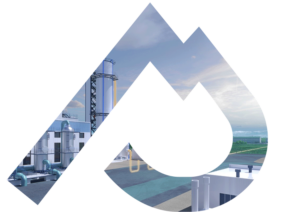
CO2 transport
through a highly secure network
Between the capture point and its final storage or utilisation destination, one key step is the safe transport of the CO2. A network of dedicated underground pipelines will allow this transport as part of the Pycasso project. Its development will be modelled on the development of the natural gas grid with an inherent level of safety that satisfies the government’s expectations.
CO2 transport from the capture points to the utilisation or storage points
Once captured, the CO2 is transferred to sites where it will be utilised or stored. Teréga will be responsible for this crucial stage for the Pycasso project. As a specialist in gas transport for nearly 80 years, the company foresees the development of a network of underground pipelines. It will comprise a main line, linked to the capture points among the territory’s major industries and to the utilisation locations or identified useable land-based geological storage sites. Other smaller-scale emitters will be connected to the main pipeline in a subsequent phase, through branch lines.
To offer an alternative to ocean sequestration, additional import/export points are also being studied, such as the port areas of Bayonne, Bordeaux and Port-la-Nouvelle. The currently favoured development route extends from Martres-Tolosane to Bayonne (maritime import terminal).
Industry has been approached to help define the backbone of the route, so that its needs can be assessed and the outline of a corridor that will meet their expectations sketched out. Over the course of the structural studies, that corridor will be narrowed down until a route is obtained, finalised at the end of a close collaboration with the government and all stakeholders, and ensuring protection of the local people and environment.
Grid safety is a key consideration, to prevent any human or ecological risk. The main hazard of CO2 transport by pipeline is an accidental leak. Expertise is central to the project’s implementation, working in accordance with regulatory demands and requirements, to protect the environment and the people. Teréga’s mastery of the development and operation of transport infrastructures in the gas industry brings with it the guarantee of totally safe, controlled installations.
Understanding CO2 transport
A network of underground pipelines will provide the link between the different emission sites and the final storage or utilisation destination. A main pipeline, connecting the major industrial actors, will be supplemented by connections to the secondary capture points.
Industrial consultation will help identify the sector’s needs. The biggest emitters serve as anchor points for the main corridor, leading to the territory’s major storage site, the re-use site, and/or the preferred maritime import/export site. The established corridor will then be reduced down to a refined route, based on technical studies conducted and their degree of advancement, any natural barriers to be crossed, protected areas that need to be bypassed and the protection of local people. Teréga will draw on a tried and tested methodology, based on three main principles:
- Avoiding areas with significant environmental challenges when outlining the project.
- Reducing the effects of the work during development, to protect the environment and human activities.
- Compensating for residual impacts associated with the project, once the work has finished, by protected spaces and recreating protected natural environments.
Obtaining administrative permits to build and operate gas pipelines is subject to various studies, conducted in collaboration with project and territorial stakeholders. CO2 transport imposes many safety precautions. The economic viability of the programme is also taken into consideration, before it is submitted to the Ministry of the Environment for an official application, examination of which will then be processed in the territory by the DREAL (Regional Department for Environment, Planning and Housing).
Once the application has been submitted to the Ministry of the Environment and forwarded to the DREALs of the regions affected by the project, an administrative conference is ordered by the Prefect, so that all the local communities can be informed, giving them the opportunity to express their views. A one-month public inquiry offers each commune an opportunity to set out its problems and concerns on the matter. An investigating commissioner then acts as representative to the actors involved in designing the project and gathers their responses. For a project the size of Pycasso, a public debate will be organised at a national level.
The preferred route for the Pycasso project runs from Martres-Tolosane (the capture point of the Lafarge cement works), around the outskirts of Pau (interesting geological sites for sequestration development), to the port of Bayonne (optional CO2 importation to the storage sites developed as part of the project). An alternative route leading to the port of Bordeaux, which may export CO2, is being studied, along with a subsequent extension to Port-la-Nouvelle.
CO2 transport and storage activities are expected to have the characteristics of a monopoly. As such, they should be subject to regulation by an independent supervisory authority, the Energy Regulation Commission (CRE). So far, the rules that will apply are still to be established, but the financing of those infrastructures should be done through the application of tariffs defined by the CRE and applied to users, modelled on the existing natural gas model. Public subsidies could also help finance those infrastructures.
